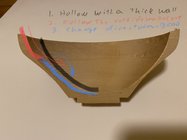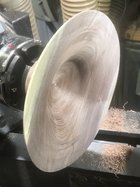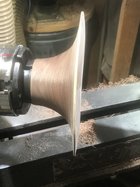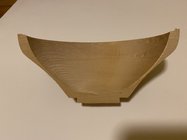-
We just finished moving the forums to a new hosting server. It looks like everything is functioning correctly but if you find a problem please report it in the Forum Technical Support Forum (click here) or email us at forum_moderator AT aawforum.org. Thanks! -
Beware of Counterfeit Woodturning Tools (click here for details) -
Johnathan Silwones is starting a new AAW chapter, Southern Alleghenies Woodturners, in Johnstown, PA. (click here for details) -
Congratulations to Dave Roberts for "2 Hats" being selected as Turning of the Week for April 22, 2024 (click here for details) -
Welcome new registering member. Your username must be your real First and Last name (for example: John Doe). "Screen names" and "handles" are not allowed and your registration will be deleted if you don't use your real name. Also, do not use all caps nor all lower case.
You are using an out of date browser. It may not display this or other websites correctly.
You should upgrade or use an alternative browser.
You should upgrade or use an alternative browser.
convex curve inside bowl
- Thread starter Richard Morgan
- Start date
- Joined
- Feb 28, 2021
- Messages
- 1,226
- Likes
- 1,076
- Location
- Roulette, PA
- Website
- www.reallyruralwoodworks.com
Practice is a large part of it, One thing that helped me at first was doing the hollowing of the bowl in increments - half an inch of depth at a time, get close to the final thickness (save one or two light finish cuts, unless doing thin once-turned from green, where I'll do final cut before moving on to the next section) use your fingers (lathe off of course!) to feel the wall thickness on each step , and you can figure out where you are starting to go off the curve and adjust.
Technique, kinda depends on your gouge grind - since I use a 55 degree (or so) bevel on my ellsworth grind I have to start the initial cut with arm out over the lathe and as I start into the curvature, pull handle in until it snugs up tot the body then move body to control the cut. If your left hand is properly anchoring the tool (and only anchoring it) to the tool rest, it also becomes your pivot point so as you swing gouge handle towards you (or sway/twist body to the left) the gouge will naturally follow that same curvature. It takes some practice between technique and "feeling" or otherwise checking wall thickness as you work your way down the bowl.
Finger & thumb make excellent depth gauges - you can learn to feel even a slight difference in wall thickness of the wood - often just as well as any digital caliper could show you. Once you can match your outside shape to the inside by learning to maintain a consistent wall thickness, by that time you can likely "eyeball" the inside curvature that you're after just by the feel of how you're working the gouge.
Technique, kinda depends on your gouge grind - since I use a 55 degree (or so) bevel on my ellsworth grind I have to start the initial cut with arm out over the lathe and as I start into the curvature, pull handle in until it snugs up tot the body then move body to control the cut. If your left hand is properly anchoring the tool (and only anchoring it) to the tool rest, it also becomes your pivot point so as you swing gouge handle towards you (or sway/twist body to the left) the gouge will naturally follow that same curvature. It takes some practice between technique and "feeling" or otherwise checking wall thickness as you work your way down the bowl.
Finger & thumb make excellent depth gauges - you can learn to feel even a slight difference in wall thickness of the wood - often just as well as any digital caliper could show you. Once you can match your outside shape to the inside by learning to maintain a consistent wall thickness, by that time you can likely "eyeball" the inside curvature that you're after just by the feel of how you're working the gouge.
Thanks Brian, That's a pretty clear explanation and more or less the technique I follow, sometime pretty well and sometimes hardly at all. What I don't really get is how do I "guide" the cutting edge of the gouge to create a convex or concave surface? It seems to me that I should be doing something similar to cutting a bead or cove in spindle work to achieve the curve I want but that doesn't seem to work with a bowl gouge.
- Joined
- Feb 28, 2021
- Messages
- 1,226
- Likes
- 1,076
- Location
- Roulette, PA
- Website
- www.reallyruralwoodworks.com
Yeah , it is hard to describe , but basically if you can lock in the gouge handle in relation to your body, with gouge anchored (side to side, not in and out) to the tool rest, you kind of lean left while swiveling ...think of sitting in an office chair and leaning sideways, you would slide the tool in and out to follow depth while at the same time you'll be swiveling your right side away from the lathe, or towards the lathe to control the wall thickness.. which determines the curve -
In other words, think of the bevel of the tool as your "pointer" and point it the direction you want the cut to go, bevel floats along behind the cut , and if your left hand is the pivot, your right side swivel controls where the bevel points (towards the inside of bowl to create the concave curve, or towards outside of bowl to create the convex curvature) It is somewhat like turning a bead, - a similar motion, but "on its side" , I guess - perhaps somewhat akin to taking the motion to turn a bead and tilt it 90 degrees to the side.
Best way I can describe it, FWIW.
In other words, think of the bevel of the tool as your "pointer" and point it the direction you want the cut to go, bevel floats along behind the cut , and if your left hand is the pivot, your right side swivel controls where the bevel points (towards the inside of bowl to create the concave curve, or towards outside of bowl to create the convex curvature) It is somewhat like turning a bead, - a similar motion, but "on its side" , I guess - perhaps somewhat akin to taking the motion to turn a bead and tilt it 90 degrees to the side.
Best way I can describe it, FWIW.
Thanks, that really is helpful. I suppose I have heard about "bevel as pointer" but it never clicked until reading this.
Thanks
Richard
Thanks
Richard
What Brian said about using the bevel as a pointer is a good guide. I will point out that when you do this, it puts the handle cocked away from you and more towards the headstock than you will be used too. It feels like you are leaning over the lathe as you work on the upper part of the rim.
Since you are fairly close by, If you would like a one-on-one to see my process send me a PM and we can schedule something.
- Joined
- Apr 27, 2004
- Messages
- 8,642
- Likes
- 4,983
- Location
- Lakeland, Florida
- Website
- www.hockenberywoodturning.com
First off the inside contour doesn’t have to match the outside contour. A curve similar to yours looks pleasing to the eye.
The way I would follow the outside is in sort of three steps
Thick wall, cove at the top, then a bead
Using calipers every few cuts will tell you when to cut deeper or shallower. After a few bowls with this design you can measure less often.

The way I would follow the outside is in sort of three steps
Thick wall, cove at the top, then a bead
Using calipers every few cuts will tell you when to cut deeper or shallower. After a few bowls with this design you can measure less often.

As others said, the bevel creates the path - the operator steers the bevel through the path. No special technique required. Instead of working toward a concave path, work toward a convex path. Just so happens I turned one last night, pics below.
This was a relatively dry walnut blank that had some drying cracks in it, which guided my ending shape, cutting them out. I didnt completely succeed, the rim has a crack a couple inches long, but I was able to finish it w/o it blowing up (face shield on and out of the line of fire). The rim is already starting to “wave” so it had some moisture in it.


This was a relatively dry walnut blank that had some drying cracks in it, which guided my ending shape, cutting them out. I didnt completely succeed, the rim has a crack a couple inches long, but I was able to finish it w/o it blowing up (face shield on and out of the line of fire). The rim is already starting to “wave” so it had some moisture in it.


thanks very helpful, I just turned the outside of the next attempt will try this on the inside.First off the inside contour doesn’t have to match the outside contour. A curve similar to yours looks pleasing to the eye.
The way I would follow the outside is in sort of three steps
Thick wall, cove at the top, then a bead
Using calipers every few cuts will tell you when to cut deeper or shallower. After a few bowls with this design you can measure less often.
View attachment 48033
Well, not sure how much sense this makes, but you turn the inside the same way you do the outside. Only difference is that on the outside you start at the bottom and work up to the rim, and on the inside you start at the rim and work down to the bottom. I do take larger bowls, like 12 inch or more, down in about 1 inch increments. The main thing to watch out for is going through the curve at the bottom of the thick area on the one you cut in half. It takes some practice.
robo hippy
robo hippy

